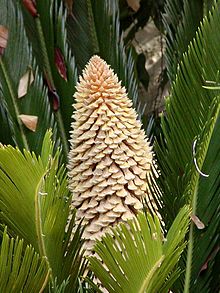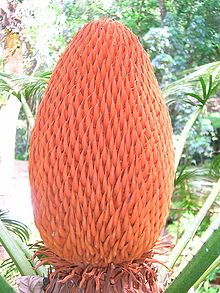- Cycas
-
Cycas 
Leaves and male cone of Cycas revoluta Scientific classification Kingdom: Plantae Division: Cycadophyta Class: Cycadopsida Order: Cycadales Family: Cycadaceae
PersoonGenus: Cycas
L.Species See Species Section
Cycas is the type genus and the only genus currently recognised in the cycad family Cycadaceae. About 95 species are currently accepted. The best-known species is Cycas revoluta, widely cultivated under the name "Sago Palm" or "King Sago Palm" due to its palm-like appearance although it is not a true palm. The generic name comes from Greek Koikas, and means "a kind of palm".
The genus is native to the Old World, with the species concentrated around the equatorial regions. It is native to eastern and southeastern Asia including the Philippines with 10 species (9 of which are endemic), eastern Africa (including Madagascar), northern Australia, Polynesia, and Micronesia. Australia has 26 species, while the Indo-Chinese area has about 30. The northernmost species (C. revoluta) is found at 31°N in southern Japan. The southernmost (C. megacarpa) is found at 26°S in southeast Queensland, Australia.
The plants are dioecious, and the family Cycadaceae is unique among the cycads in not forming seed cones on female plants, but rather a group of leaf-like structures each with seeds on the lower margins, and pollen cones on male individuals.
The caudex is cylindrical, surrounded by the persistent petiole base. Most species form distinct branched or unbranched trunks but in some species the main trunk can be subterranean with the leaf crown appearing to arise directly from the ground. The leaves are pinnate (or more rarely bipinnate) and arranged spirally, with thick and hard keratinose. The leaflets are articulated, have midrib but lack secondary veins. Megasporophylls are not gathered in cones.
Often considered a living fossil, the earliest fossils of the genus Cycas appear in the Cenozoic although Cycas-like fossils that may belong to Cycadaceae extend well into the Mesozoic. Cycas is not closely related to other genera of cycads, and phylogenetic studies have shown that Cycadaceae is the sister-group to all other extant cycads.
The plant takes several years to grow, sexual reproduction takes place after 10 years of exclusive vegetative growth.
Selected species
Cycas aculeata
Cycas angulata
Cycas annaikalensis
Cycas apoa
Cycas arenicola
Cycas armstrongii
Cycas arnhemica
Cycas badensis
Cycas balansae
Cycas basaltica
Cycas beddomei
Cycas bifida
Cycas bougainvilleana
Cycas brachycantha
Cycas brunnea
Cycas cairnsiana
Cycas calcicola
Cycas campestris
Cycas candida
Cycas canalis
Cycas chamaoensis
Cycas changjiangensis
Cycas chevalieri
Cycas circinalis
Cycas clivicola
Cycas collina
Cycas condaoensis
Cycas conferta
Cycas couttsiana
Cycas curranii
Cycas debaoensis
Cycas desolata
Cycas diannanensisCycas dolichophylla
Cycas edentata
Cycas elephantipes
Cycas elongata
Cycas falcata
Cycas fairylakea
Cycas ferruginea
Cycas fugax
Cycas furfuracea
Cycas guizhouensis
Cycas hainanensis
Cycas hoabinhensis
Cycas hongheensis
Cycas inermis
Cycas javana
Cycas lanepoolei
Cycas lindstromii
Cycas litoralis
Cycas maconochiei
Cycas macrocarpa
Cycas media
Cycas megacarpa
Cycas micholitzii
Cycas micronesica
Cycas multipinnata
Cycas nathorstii
Cycas nongnoochiae
Cycas ophiolitica
Cycas orientis
Cycas pachypoda
Cycas panzhihuaensis
Cycas papuana
Cycas pectinata
Cycas petraea
Cycas platyphylla
Cycas pranburiensis
Cycas pruinosa
Cycas revoluta
Cycas riuminiana
Cycas rumphii Miq.
Cycas schumanniana
Cycas scratchleyana
Cycas seemannii A.Braun
Cycas segmentifida
Cycas semota
Cycas sexseminifera
Cycas siamensis
Cycas silvestris
Cycas simplicipinna
Cycas spherica
Cycas szechuanensis
Cycas taitungensis
Cycas taiwaniana
Cycas tanqingii
Cycas tansachana
Cycas thouarsii
Cycas tropophylla
Cycas tuckeri
Cycas wadei
Cycas xipholepis
Cycas yorkiana
Cycas yunnanensis
Cycas zambalensis
Cycas zeylanica
References and external links
- Hill KD (1998-2004) The Cycad Pages, Royal Botanic Gardens Sydney. http://plantnet.rbgsyd.nsw.gov.au/PlantNet/cycad/index.html
- Singh, R., & Radha P. (2006). Cycas annaikalensis, A new species of Cycas from the Malabar Coast, Western Ghats, India. Brittonia 58 (2): 119-123.
- Virtual Cycad Encyclopedia edited by the Palm & Cycad Societies of Florida
- David J. de Laubenfels, Cycas Taxonomy
- Ken D. Hill, Dennis W. Stevenson & Roy Osborne (2004) "The World List of Cycads". The Botanical Review, 70(2)274–298 doi:10.1663/0006-8101(2004)070%5B0274:TWLOC%5D2.0.CO;2
- Lindstrom, Anders J. and Ken D. Hill (2007) "The genus Cycas (Cycadaceae) in India". Telopea 11(4) : 463-488.
- David J. de Laubenfels & F. Adema (1998) "A taxonomic revision of the genera Cycas and Epicycas Gen. Nov. (Cycadaceae)", Blumea 43()351-400.
- Terrence Walters & Roy Osborne (eds.) (2004), Cycad Classification: Concepts and Recommendations, CABI publishing, ISBN 0-85199-741-4
Categories:
Wikimedia Foundation. 2010.


